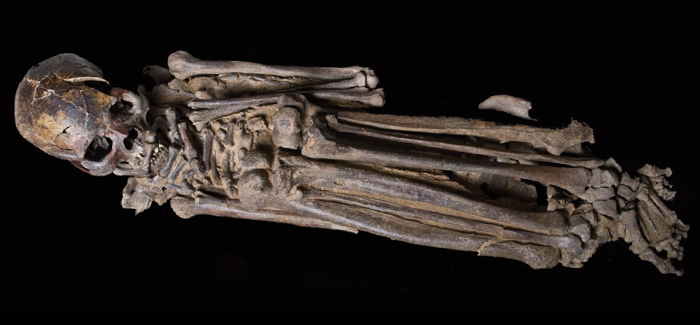
The accordion man, folded up tight. (Sereno PC, Garcea EAA, Jousse H, Stojanowski CM, Saliège J-F, et al, [2008] “Lakeside Cemeteries in the Sahara: 5,000 Years of Holocene Population and Environmental Change,” PLoS ONE 3(8): e2995.)
Dinosaur hunter Paul Sereno uses digital imagery to help a 10,000-year-old skeleton stand and walk.
UChicago paleontologist Paul Sereno made headlines a few years ago by discovering, amid the dunes of Niger’s once-green Sahara, a huge Stone Age cemetery. The largest ever excavated, it stretched out alongside what had been a lake filled with fish and crocodiles and turtles and clams. The oldest skeletons date back 10,000 years. In all, there were some 200 graves, and some of the skeletons were meticulously posed: an 11-year-old girl wearing a hippo-tusk bracelet, a man seated upright on a mud turtle carapace, a woman and two children reaching toward each other in an eternal embrace. A dinosaur hunter all his career—just earlier he had dug up the fossil of an ancient 40-foot crocodile in the Sahara—Sereno found himself fascinated by these human bones. He told National Geographic, “There is something soul stirring about looking into the face of an ancient human skull and knowing this is my species.”
And so this spring, in the middle of a talk at Crerar Library about how CT scanners and digital software are revolutionizing the study of dinosaur fossils, Sereno took a moment to explain how those technologies had also deepened his understanding of the Green Sahara graves, and the people who were buried there. One example: the skeleton Sereno and his team took to calling “accordion man,” because his limbs were all tightly folded into his body, knees to the chest, elbows bent sharply. “He had a beautiful pose,” Sereno said, “both hands over the mouth, and both feet crossed. In fact, he was so tight that he would fit into a ten-inch cylinder—indicating probably that he was bound for his burial, and bound probably not long after he died.”
Sereno didn’t want to spoil that beautiful pose, or lose the archaeological information in it, but he wanted to know what the accordion man might have looked like standing up, walking around, with flesh on his bones and features on his face. To figure out how tall he’d been, Sereno and his team, including University of Illinois at Chicago graduate students, used a CT scanner to measure the stature-bearing bones, “from the calcaneal heel, right up through the hip socket, into the sacrum, right up through the axial column, to the axis and to the top of the head.” Adding the numbers together and throwing in a “soft anatomy factor,” they calculated a height of six feet two inches, slightly shorter than initial estimates had predicted.
Then they made him walk. “Just to see it,” Sereno said, pressing play on a short animation clip. On the screen at the front of the room, the accordion man seemed to awaken from his slumber, and then slowly, bone by bone, he got to his feet, drawing his hands away from his face, sitting upright, and pushing himself off the ground, as his hips and knees unfurled, his body lengthening until he stood there, arms at his sides, looking out toward the audience. It was mesmerizing. “So,” Sereno finally said, his voice puncturing the spellbound silence, “this is a surfaced, segmented skeleton that is standing again for the first time in 10,000 years.”
